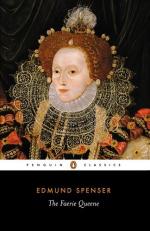295. TO MOVE, moving. This is a French idiom.
300. AS EAGLE FRESH OUT OF THE OCEAN WAVE, etc. There was an ancient belief, that once in ten years the eagle would soar into the empyrean, and plunging thence into the sea, would molt his plumage and renew his youth with a fresh supply of feathers.
312. HIS BRIGHT DEAW-BURNING BLADE, his bright blade flashing with the “holy water dew” in which it had been hardened (l. 317).
322. NE MOLTEN METTALL IN HIS BLOOD EMBREW, i.e. nor sword bathe itself in his (the dragon’s) blood.
335. WITH SHARPE INTENDED STING, with sharp, outstretched sting.
366. THE GRIPED GAGE, the pledge (shield) seized (by the dragon).
386. MISSED NOT HIS MINISHT MIGHT, felt not the loss of its diminished strength; i.e. though cut off, the paw still held to the shield.
xliv. In comparing the fire-spewing dragon to a volcano, Spenser follows Vergil’s Aeneid, iii, 571, and Tasso’s Jerusalem Delivered, iv, 8.
406. A GOODLY TREE. Cf. Genesis, ii, 9, and Revelation, xxii, 2.
409. OVER ALL WERE RED, everywhere were spoken of.
414. Cf. Genesis, iii, 2. Adam and Eve were expelled from the garden lest they should eat and live forever.
434. DEADLY MADE, a creature of death, i.e. hell-born.
469. An imitation of an incident in the Seven Champions in which a winged serpent attempts to swallow St. George; i, 1.
477. AND BACK RETYRD, and as it was withdrawn. A Gallicism.
490. WHICH SHE MISDEEM’D, in which she was mistaken. Una feared that the dragon was not dead.
QUESTIONS AND TOPICS
(Canto XI)
1. Describe the three days’ fight between the Knight and the Dragon. 2. What advantages does each gain? 3. Study the Dragon as a type of the conventional monster of romance, contrasting his brutal nature with the intellectuality and strategy of the Knight. 4. Study the battle as an allegory of the victory of mind over matter, of virtue over vice, of Protestantism over Romanism. 5. By what devices does Spenser obtain the effects of terror? Mystery and terror are prime elements in romance. 6. Find examples of another romantic characteristic, exaggeration. 7. Do you think that in his use of hyperbole and impossibilities Spenser shows that he was deficient in a sense of humor? 8. Observe the lyric note in iii and liv. 9. How does the poet impress the reader with the size of the Dragon? 10. Which Muse does he invoke? 11. Spenser’s poetry is richly sensuous: find passages in which he appeals to the sense of sight (iv, viii, xiv), of sound (iv, ix), of touch (x, xi, vii), of smell (xiii), of taste (xiii), of pain (xxxvii, xxvi, xxii), of motion (x, xv, xviii). 12. Where do you find an allegory of baptism? Of regeneration? Of the resurrection of Christ (the three days)? 13. Analyze the descriptions of the coming of darkness and of dawn.




